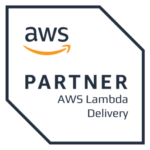AWS Lambda
Eliminate infrastructure overhead and scale infinitely with AWS Lambda.
What is AWS Lambda?
AWS Lambda is serverless compute service that runs your code in response to events and automatically manages the underlying compute resources for you, making it easier to build applications that respond quickly to new information.
With Lambda, you only pay for the compute time consumed, with no charges when idle. Lambda scales automatically, ensuring high availability, and integrates with other AWS services for seamless deployment. It supports multiple programming languages and can be triggered by AWS services or invoked directly from web and mobile apps.
Write code that delivers instant business value, with costs matching demand and operations fully automated.
Benefits
Simplicity
Experience the ease of running code without the hassle of provisioning or managing infrastructure. Simply write and upload code as a .zip file or container image.
Reduce Costs
Cut down on expenses by paying only for the actual compute time you use —by the millisecond— rather than provisioning infrastructure upfront for peak capacity.
Automated High Availability
AWS Lambda has built-in availability and fault tolerance. You don’t need to architect for these capabilities.
Effortless Scaling
Automatically respond to code execution requests at any scale, whether it is a few events per day or hundreds of thousands per second.
Observability
AWS Lambda provides built-in monitoring capabilities by automatically capturing and sending logs, metrics, and traces to Amazon CloudWatch.
Improved Performance
Optimise code execution time and performance with the right function memory size. Respond to high demand in double-digit milliseconds with Provisioned Concurrency.
How can AWS Lambda work for you?
At fourTheorem, we are experienced with using Lambda not only as a means of rapidly building Serverless Microservice platforms – but also as a tool for solving a multitude of use cases. For example:
- Integration with external APIs
- Ingesting and processing IoT sensor data
- Constructing data analysis pipelines
- Management and orchestration of Machine Learning systems
- Integration and extension of legacy compute platforms
- Transformation of monolithic systems to distributed Microservice architectures
- High performance, high scale, real-time compute workloads
AWS Bites Podcast
Best practices for working with AWS Lambda.
Learn about the mechanics of Lambda functions, including the differences between cold starts and warm starts. Explore the various invocation types—synchronous, asynchronous, and event-based—and get tips on optimising performance, reducing costs, and monitoring effectively for each type.


